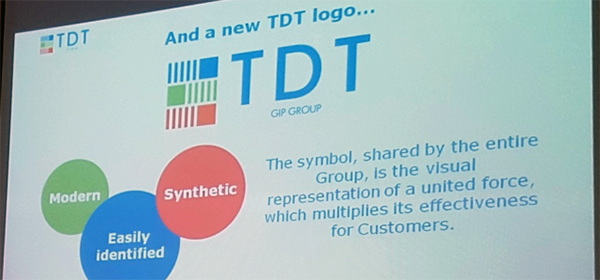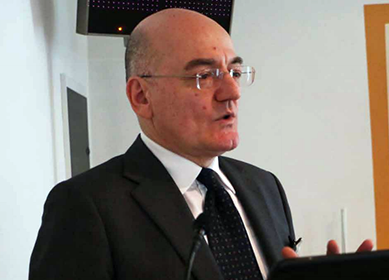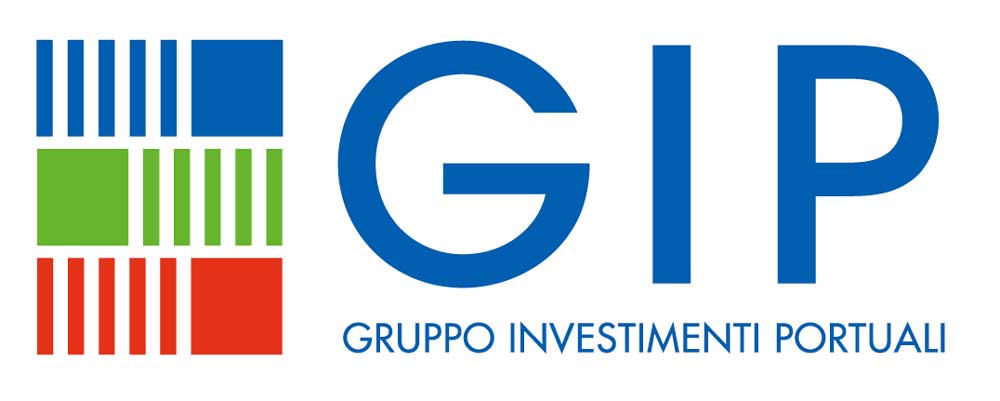
Integration for TDT and SECH
Not only a new logo: Terminal Darsena Toscana presents its development plans after its official entry into Gruppo Investimenti Portuali. Corsini relaunches the desirability of the Europe Platform.
Livorno – The management of TDT Terminal Darsena Toscana Srl was never going to miss an opportunity like the 6th Med Ports Conference to give the trade press an update on its development.
The Livorno company was thus able to paint a brighter picture of its programmes for the future in light of its official entry, along with its colleagues at SECH in Genoa, into GIP Group, and also showcase the new logo it will have in this new enterprise. A detailed presentation was delivered by GIP marketing manager Massimiliano Cozzani and TDT general manager Marco Mignogna.
Active since 1997, TDT was 50% owned by GIP (the holding company formed in 1993 that also has interests, albeit minority, in VTE Genova (30%) and Vecon Venezia (20%)) from 2010 to 2012, when GIP became the majority shareholder along with two institutional investors, the equity funds Infracapital (UK) and Infravia (FR). In 2018, TDT intends to restyle its image, as embodied in its new three-colour logo (green-red-blue).

“It’s not a merely cosmetic change but also a new philosophy, a concept bringing together integration, leanness, modernity and dialogue between the companies. We’re no longer branded TDT and SECH but GIP,” says Cozzani alluding to the inputs from the new shareholders. “The funds’ owners are insurers, so they’re keen on managing risk. Their strategy is certainly based on margins but not excluding all else or at any cost. We’d rather lose a container or two than skimp on key factors like ethics, innovation, quality or, above all, safety, as attested by our certifications, which aren’t just bits of paper. We strive to put ourselves in our customers’ shoes and satisfy them continually by anticipating and adjusting to their needs.”
Cozzani then reviewed TDT’s merits, including its most recent ones.
“The first thing was to simplify and accelerate operating standards by adopting the Navis4 system, which has unified our procedures and continued to focus on safety, to which end we also use the TPCS (Tuscan Port Community System) and the AIDA system (Customs and Excise Integrated Automation).
With 304 employees, TDT was the first Italian terminal to obtain AEO certification, and we’re now ready for full digitalization.
Most importantly, we’re proud to be the biggest reefer cargo terminal in Italy, with 863 reefer plugs and 80 in the inspection area, and traffic of 20,000 reefer TEUs in 2017 (despite the loss of an American East Coast service), a clear sign that fresh goods are preferring Livorno.”
The terminal has a 90
0,000 TEU capacity, of which 65% in use (570,000 TEUs in 2017), a 1,430 meter quay that can moor 4 vessels at once, a break bulk area, a short dwell time, 8 quay cranes, of which 2 revamped, and 6 post panamax cranes (up to 18 container rows, 48.5 meter straddle and 90 tonne capacity), 14 RTGs (1 over 5 high stacking), 20 reach stackers, 2 weighbridges and 1 scanner.
The terminal’s other advantage is its rail capability. TDT has three 1,350-meter tracks connecting it with the interports of Padova, Rubiera, Verona, Mantova, Bologna and Dinazzano, and is the first terminal to be connected to the electrified rail network.
This is considered a key factor, along with its fortunate location at the centre of an area with large spaces and good road connections enabling hauliers to make more than one trip a day from the quayside to the Guasticce dry port.
So far so good. What about the future? What strategies is TDT pondering? Where will it invest?
Mignogna mentions the recent commitment to co-operation with the Lorenzini terminal.
“We’re also grateful to the AdSP (Port Development Authority) for the widening of the Marzocco channel, which is expected to reach a width of 120 meters and a draught of 20 meters by 2021 (maybe already in 2020 according to AdSp), which will considerably upgrade its potential and appeal.
Following the works carried out for AdSP, the Port Authority issued a new order establishing a 13-meter draught and a current width of 90 meters.
Let’s not forget that MSC left because of the limited draught and then came back to Lorenzini.
And the new lighting system allows vessels to sail at night.
We can now host vessels 325 meters long and 43 meters wide, or 300 meters long and 48 meters wide, i.e. ships of up to 9-10,000 TEUs.
For its part, TDT contributed to the works on the Marzocco tower side.”
This said, what are your declared intentions now?
“Our aim is to defend existing traffic and try to increase it if possible, by developing the intermodal part,” TDT’s general manager continued, adding that “there’s a market at stake here. Our competitor is the port of La Spezia and certainly not Genoa. Livorno is complementary to the Ligurian capital, where we co-operate very closely with our colleagues at SECH, currently headed by Roberto Ferrari (formerly at TMT Trieste and Contship). We’re doing promotion work with shipowners and keeping an eye on Middle Eastern services that might come to Livorno, while it’s impossible to capture the Far Eastern ones operating with 14,000 TEU vessels.”
Investments have already been clearly defined, with the imminent purchase of two electric RTGs under a tender to be issued in the second half of 2018.
No specific declaration of intent then but a clear confirmation of what everyone is expecting, pending the final tender: “We’re looking forward with logical and understandable interest to the creation of Platform Europe,” concluded Mignogna and Cozzani.
“Angelo Scorza


